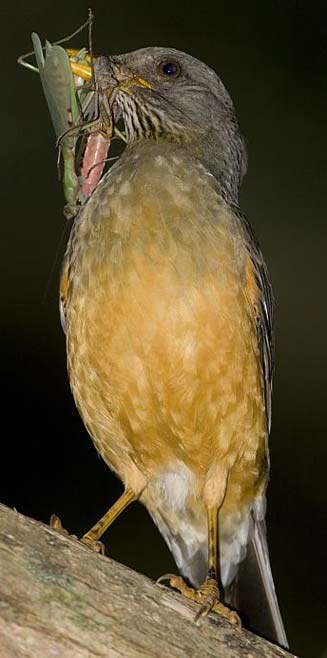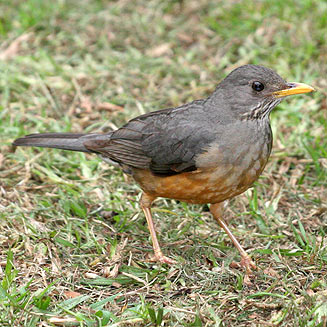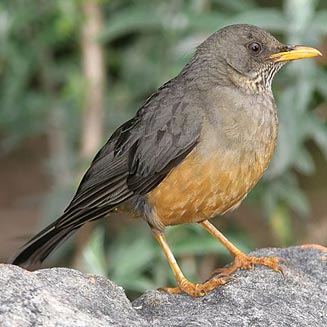|
Turdus olivaceus (Olive thrush)
Olyflyster [Afrikaans]; Umswi [Xhosa]; umuNswi (generic term for thrush)
[Zulu]; Setsipitsipi [South Sotho]; Kaapse lijster [Dutch]; Merle
olivâtre [French]; Kapdrossel, Kapamsel [German]; Tordo-oliváceo
[Portuguese]
Life
> Eukaryotes >
Opisthokonta
> Metazoa (animals) >
Bilateria >
Deuterostomia > Chordata >
Craniata > Vertebrata (vertebrates) > Gnathostomata (jawed
vertebrates) > Teleostomi (teleost fish) > Osteichthyes (bony fish) > Class:
Sarcopterygii (lobe-finned
fish) > Stegocephalia (terrestrial
vertebrates) > Tetrapoda
(four-legged vertebrates) > Reptiliomorpha > Amniota >
Reptilia (reptiles) >
Romeriida > Diapsida > Archosauromorpha > Archosauria >
Dinosauria
(dinosaurs) > Saurischia > Theropoda (bipedal predatory dinosaurs) >
Coelurosauria > Maniraptora > Aves
(birds) > Order: Passeriformes
> Family: Muscicapidae > Genus: Turdus
 |
 |
 |
| Olive thrush with praying mantis,
Kirstenbosch Botanical Gardens, South Africa. [photo Trevor Hardaker ©] |
Top right: Olive thrush, Cape Town, Western Cape, South
Africa. [photo Duncan Robertson ©]
Bottom right: Olive thrush, Kirstenbosch Botanical
Gardens, South Africa. [photo Trevor Hardaker ©] |
Distribution and habitat
Endemic to southern Africa, with the bulk of its
distribution centered on South Africa's eastern and southern coast extending to
Limpopo Province and Lesotho, with a smaller population in Zimbabwe's
eastern highlands. It generally prefers
evergreen forest, forest edges, and suburban and rural gardens, in fact it is
the 8th most common bird in Cape Town. It also occupies alien Acacia
thickets and commercial orchards.
Brood parasites
It has been recorded as host of the
Red-chested cuckoo.
Food
It mainly eats earthworms supplemented with insects, other
invertebrates and fallen fruit, doing most of its foraging on the ground,
flicking through leaf litter in search of prey. The following food items have been recorded
in its diet:
- Invertebrates
- Fruit
- Acacia cyclops (Rooikrans)
Breeding
- The nest is built solely by the female in about 10 days, consisting of a
large, moist bowl made of grass stems, twigs, earth, wet leaves and moss,
lined with plant stems, fibres, tendrils and bracken. It is typically in the
fork of a tree branch, especially in gardens, anywhere from 3-16 metres
above ground.
- Egg-laying season is basically year-round, peaking from August-December.
- It lays 2-3 eggs, which are incubated solely by the female for about 14
days, occasionally leaving the nest for up to an hour to forage.
- The chicks are brooded mainly by the female for the first 2 days, and is
also responsible for feeding them with food passed to her by the male for
the first few days. Later both parents feed the young, who leave the nest at
about 16 days old, when they can barely fly; they remain dependent on their
parents for up to 2 months further.
Threats
Not threatened, in fact it has adapted extremely well to
the introduction of man-made habitats.
References
-
Hockey PAR, Dean WRJ and Ryan PG 2005. Roberts
- Birds of southern Africa, VIIth ed. The Trustees of the John Voelcker
Bird Book Fund, Cape Town.
|
